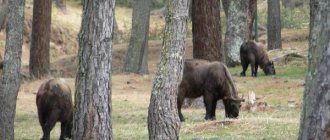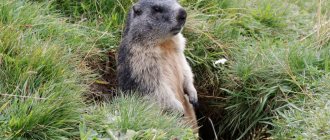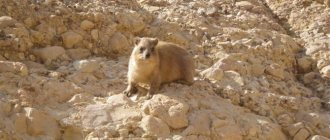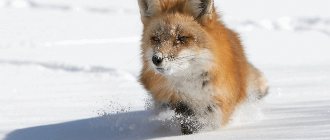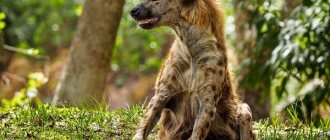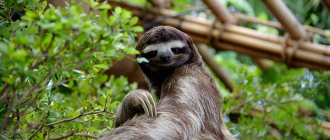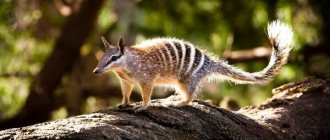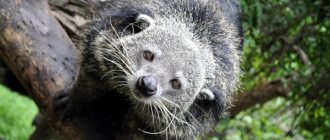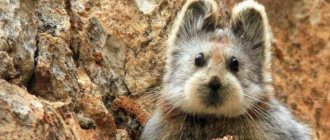- Wild animals
- >>
- Mammals
It is safe to say about the goitered gazelle that it is as graceful as a gazelle. The combination of long and slender legs with graceful horns that have beautiful curves makes this antelope even more elegant and sophisticated. Looking at how the gazelle from one stone to another, you can immediately notice its lightness, dexterity and grace. Let's find out everything about the origin of this animal, characterize its disposition, habits, favorite habitats and eating habits, note the main enemies of goitered gazelles in order to understand in more detail the life activity of these artiodactyls.
Origin of the species and description
Photo: Jeyran
The gazelle is an artiodactyl mammal belonging to the genus of gazelles and the bovid family. This genus is directly related to the subfamily of true antelopes. The word "gazelle" came to us from the Arabic language. In general, this is a genus of rather slender and long-legged animals, which is confirmed by the graceful gazelle’s appearance. There are many varieties of gazelles, among them you can see the goitered gazelle. This antelope has one peculiarity - only male gazelles have horns, unlike most other gazelles, where individuals of both sexes act as cuckolds.
As for goitered gazelles specifically, they can be called small and very sophisticated-looking animals, all of whose external features and build are in full accordance with the gazelle genus, although they have their own nuances and distinctive features. In general, there are 4 subspecies of gazelles, but now some scientists classify them as separate species.
So, among goitered gazelles there are:
- Persian;
- Mongolian;
- Turkmen;
- Arabian.
It is worth noting that in appearance these subspecies are almost identical, and differ only in the territory of their permanent residence. The grace, dexterity and swiftness of the goitered gazelle have long admired people, so they were often depicted on coins and postage stamps of the former USSR, Kazakhstan, Azerbaijan and Russia.
Dzheyran on postage stamps and coins
- 1985 CPA 5662.jpg
USSR stamp. 1985
- Stamp of Kazakhstan 485-487.jpg
Block of Kazakhstan postage stamps. 2004
- Stamps of Azerbaijan, 2014-1151.jpg
Postage stamp of Azerbaijan. year 2014.
- RR5516-0006R.gif
Coin of the Bank of Russia. Series "Red Book". 50 rubles, reverse.
- 1 Rubel Kropfgazelle.png
Coin of the Bank of Russia. “Red Book” series, silver, 1 ruble, 1997
- Coin of Kazakhstan 500Dzheiran-rev.jpg
Commemorative coin of the Republic of Kazakhstan. Series “Red Book of Kazakhstan”. 500 tenge, reverse. Silver 925.
Appearance and features
Photo: Steppe goitered gazelle
First, let's look at the dimensions of these amazing antelopes. The body length of mature animals can vary from 93 to 116 cm, and their height at the withers can range from 60 to 75 cm. The weight of goitered gazelles ranges from 18 to 33 kg. As already noted, only males act as cuckolds among goitered gazelles. Their beautiful lyre-shaped horns are painted black, have a length of 28 to 30 cm and are studded with a number of transverse rings. Females are not endowed with horns, but sometimes there are specimens with small rudimentary horns from 3 to 5 cm in length.
Gazelle gazelles are long-legged creatures, their limbs are graceful and thin, but their hooves are quite powerful and sharp, which facilitates the fast and dexterous movement of these gazelles on rocky and clayey soil. However, the legs of antelopes are completely unsuited for moving on a snow carpet, and goitered gazelles do not have much endurance, so they often die when forced to make long treks.
Video: Jeyran
If we talk about the coloring of these animals, then it is mostly sandy (the upper part of the body and sides). White coloring is noticeable on the neck, abdomen and inside of the legs. In the back part you can see a small white area called the “mirror”. The tip of the tail is black, it stands out in contrast against a white background, and is clearly visible when the goitered gazelle rushes rapidly. Because of this distinctive external feature, it is often popularly called the “black tail.” A pronounced division of the hair into undercoat and guard hairs is not noticeable in goitered gazelles. In winter, their fur coat is lighter than their summer clothing. The length of the fur of the winter plumage ranges from 3 to 5 cm, and in summer it does not even reach 1.5 cm. It should be added that the hairs on the muzzle and legs are shorter than on the rest of the antelope’s body.
Interesting fact: Young goitered gazelles have a strongly pronounced facial pattern, which consists of a dark brown spot on the bridge of the nose and two dark stripes running from the antelope’s eyes to the corners of its mouth.
Lifestyle and habitat
The gazelle lives on rocky clay soils of deserts and semi-deserts, choosing flat or slightly hilly areas. These antelopes do not like to move far; they usually roam in winter, walking about 30 km a day.
The animal's main activity time is early morning and evening. This can be explained simply: during the day it is very hot in the desert and antelopes are forced to hide in shady places. In winter, the animal is active throughout the day.
Dzheyran male
At night, goitered gazelles rest on their beds. The beds are small oval depressions on the ground. Goitered gazelles use them several times and always leave their droppings at the edge of the hole. Favorite position for sleeping - the neck and head, together with one leg, are extended forward, the other legs are tucked under the body.
Individuals communicate with each other using vocal and visual signals. Capable of frightening the enemy: the warning begins with a loud sneeze, then the gazelle loudly hits the ground with its front hooves. This ritual is a kind of command for the fellow tribesmen of the defending individual - the rest of the herd suddenly jumps up and runs away.
What the gazelle looks like during the molting period remains a mystery. Natural scientists have rarely been able to capture an animal with obvious signs of this process. It has been established that the goitered gazelle molts twice in a year. The first molt begins after the end of the winter period and lasts until May. If the animal is exhausted or sick, then the molting period begins later. The summer fur of these animals is darker than winter, and thinner and sparse, only 1.5 cm. The second molting period begins at the end of August.
Dzheyrans are a symbol and personification of the desert. Long-legged gazelles live in difficult climatic conditions and have many enemies. How does nature help them survive? Interesting facts about the life of goitered gazelles:
— One of the unique features that helps gazelles survive during periods of long drought: the ability to reduce the volume of internal organs that absorb oxygen - the heart and liver, by reducing the respiratory rate. This allows goitered gazelles to reduce the loss of accumulated fluid in the body by 40%.
Goitered gazelles run fast and jump high
— Protective coloring allows the goitered gazelle to blend into the landscape, which gives them another chance for survival: if you fail to escape, you can hide.
— Excellent peripheral vision and the ability to make team decisions: scientists were able to observe how goitered gazelles, engaged in fights during the rutting period, suddenly noticed an approaching predator, at one moment, they made jumps to the side synchronously and at the same time, as if on command. With the danger gone, they calmly returned to their battles.
— The goitered gazelle has received the nickname “black tail” among the people. When very frightened, the antelope takes off running, while it raises its black tail up, which stands out sharply against the background of the white “mirror”.
— The unique structure of the larynx gives goitered gazelles original vocal abilities - contributes to a low timbre of the voice. In males, the larynx is low, and in structure it can be compared with the larynxes of four animals, one of which is human. Thanks to this feature, it is able to emit a low, rough sound, which makes it seem to its enemies and opponents that the individual is larger and more powerful than it actually is.
Where does the gazelle live?
Photo: Goitered gazelles in the desert
Goitered gazelles give their preference to plains and slightly hilly, ridged deserts, where the soil is quite dense. This elegant antelope can be found both in the area of mountain trails and in valleys with soft terrain. Due to the peculiarities in the structure of their limbs, these animals avoid very large sandy areas, this is especially true in the summer.
Very often goitered gazelles love deserts and semi-deserts, occupying:
- cereal-hodgepodge semi-deserts;
- semi-shrub saltwort semi-deserts;
- shrub deserts.
Interesting fact: The vegetation in the territories where goitered gazelles live can differ significantly and be completely diverse. Often these antelopes adapt to existing in the vastness of almost lifeless rocky deserts.
Speaking about specific territories of gazelle settlement, it is worth noting that they currently live:
- in Iran;
- in western Pakistan;
- in the south of Mongolia;
- in Afghanistan;
- on the territory of China;
- In Kazakhstan;
- Georgia;
- Kyrgyzstan;
- Tajikistan;
- Uzbekistan;
- Turkmenistan.
As for our country, according to the historical habitat, goitered gazelles in the recent past lived in the southern part of Dagestan, but now, unfortunately, they are not found there, giving their preference to the desert and semi-desert areas of the above-mentioned states.
Security status
In the 1900s, goitered gazelles were abundant and could be found in almost every desert and semi-desert region throughout the Middle East and Central Asia. Already in 2001, their entire population was estimated at 120,000-140,000 individuals. A significant decline has occurred in the last decade, and the rate of decline has increased by 30%. They have become very rare in Turkmenistan, Kazakhstan, southeast Turkey and Azerbaijan.
Major threats include rampant poaching and habitat destruction. Habitat destruction primarily occurs due to economic and agricultural development. In Central Asia, severe winters have had a significant negative impact on goitered gazelle populations. Goitered gazelles have the status of a vulnerable species.
Video
What does the goitered gazelle eat?
Photo: Goitered gazelle antelope
It should not be surprising that goitered gazelles are not very demanding in terms of nutrition, because they live in desert and semi-desert territories that are quite sparse in terms of vegetation. You don’t have to be picky, so goitered gazelles are happy with what they have on their ascetic menu, the composition of which is very limited, especially in autumn and winter.
During this period, goitered gazelles snack on:
- camel thorn;
- hodgepodge;
- wormwood;
- saxaul shoots;
- twig;
- ephedra;
- superficial part of tamarisks.
In summer and spring, the menu looks richer and juicier, because plant life resumes again. During this period, goitered gazelles can eat wild cereals, capers, ferula, barnyard grass, onions, and sometimes feast on corn, melon, and legumes. As desert dwellers, goitered gazelles are accustomed to going for long periods without drinking. This is not surprising, because the nearest watering hole can be located at a distance of 10 to 15 km, so antelopes drink water once a week or five days.
On the shores overgrown with bushes, goitered gazelles try not to drink, because various predators may be hiding there. For watering, antelopes choose open and flat terrain, going on a hike for water at dusk or when dawn breaks. Animals do all this for their own safety. Even bitter-tasting and salty water (for example, in the Caspian Sea) is consumed by goitered gazelles, once again emphasizing their unpretentiousness regarding food preferences.
Nutrition
The goitered gazelle is a herbivore and gregarious animal . The basis of its diet is young shoots of bushes and lush grass: barnyard grass, capers, wormwood. In total, they eat more than 70 different types of herbs. There is little water in deserts, so they have to move around several times a week in search of drink.
gazelles are unpretentious ungulates; they can drink both fresh and salt water, and can survive without water at all for up to 7 days. They reach the peak size of the herd in winter: the mating period is over, the females have returned with grown-up cubs.
Winter is a difficult period for Asian gazelles. Due to deep snow and ice crust, a significant part of the herd dies. The main enemies of goitered gazelles are wolves, but they are also actively hunted by golden eagles and foxes.
Gazelle antelopes are shy animals, any noise causes them to panic, and they can reach running speeds of up to 60 km/h, and young individuals simply cling to the ground, merging with it due to the peculiarities of their color.
Their relationship with humans also did not work out: people mercilessly shot these animals because of their tasty meat, which reduced their numbers significantly. Now the goitered gazelle is listed in the Red Book .
Features of character and lifestyle
Photo: Dzheyran from the Red Book
Like other gazelles, goitered gazelles are very cautious and timid; they react with great sensitivity to any suspicious sounds and noises. If the antelope senses danger, it immediately takes off running; its running speed can range from 55 to 60 km per hour. Females with babies have a completely different rescue tactic - they, on the contrary, prefer to hide in the bushes in such terrible moments.
Although goitered gazelles are herd animals, they begin to gather in large groups when winter is quickly approaching. In the warm months, these gazelles like to be completely alone or in a small company, where at most there can be only five goitered gazelles. Basically, these are last year's young animals and barren females.
With the approach of cold weather, goitered gazelles begin to cluster in large herds, which can contain from several tens to several hundred animals. When herds of antelope look for food, they are able to travel from 25 to 30 km in one day. With the arrival of spring, pregnant females begin to be the first to leave the herd, then it is the turn of sexually mature males, followed by the already sufficiently strong young animals leaving the herd.
Interesting fact: In winter, goitered gazelles are active during the day, and at twilight and at night they rest in beds dug out in the snow, which are usually arranged behind some hill to protect themselves from the cold wind. In the summer, antelopes, on the contrary, feed in the morning and at dusk, and on a hot day they rest, sitting somewhere in the shade.
Social structure and reproduction
Photo: Steppe goitered gazelle
As noted earlier, goitered gazelles are collective mammals, living in herds into which they gather during the onset of winter cold. And in the fall, mature males begin an active rut. They mark their properties with excrement, which they place in pre-dug holes called “rutting latrines.”
Interesting fact: Males become aggressive during the rut, often gathering around themselves entire harems of females, which they tirelessly protect from the attacks of other suitors. The struggle for territory and attracting female attention comes to the point that some gentlemen dig up other people's marks and replace them with their own.
The duration of the female's pregnancy is 6 months; calves appear in March or closer to the beginning of April. Usually, one single or a couple of babies are born. A few weeks before the birth of their offspring, expectant mothers try to stay apart, away from males, choosing a place suitable for childbirth, which should be located in a flat, open area where there is sparse bush growth, or in a ravine, reliably sheltered from cool winds.
The little ones weigh about two kilograms, but they can immediately stand on their feet and feel quite confident. During the first weeks of their life, calves find refuge in the bushes, where they prefer to hide, and a caring mother herself visits them, feeding them breast milk 3-4 times a day. The development of goitered gazelle cubs occurs very rapidly. Already during the first month of life, they gain weight equal to half the weight of an adult animal.
Calves become fully adult when they are closer to one and a half years old, although some females already have offspring for the first time at the age of one. Sexual maturity of males occurs only at 1.5 years of age. In their natural environment, goitered gazelles can live for about 7 years, and in captivity, up to 10.
Notes
Wiktionary has an entry for "Gazelle gazelle"
Comments
- According to other sources, body length is 94–115 cm[3]
Sources
- Sokolov V. E.
Five-language dictionary of animal names. Mammals. Latin, Russian, English, German, French. / under the general editorship of academician. V. E. Sokolova. - M.: Rus. lang., 1984. - P. 132. - 10,000 copies. - ↑ 12345
Mammals of the USSR, 1970, p. 221. - ↑ 12
Biology. BES, 1998, p. 175. - Range map (IUCN).
- ↑ 1234567891011
Castello JR (2016) Bovids of the World: Antelopes, Gazelles, Cattle, Goats, Sheep, and Relatives. — Princeton University Press. - Pp. 150-157. — 664 p. — ISBN 978-0-691-16717-6 [books.google.com.ua/books?id=KVwzCwAAQBAJ&printsec=frontcover&hl=ru#v=onepage&q&f=false] - ↑ 1234
Bucknell Univ. Biol. Dep..
Natural enemies of the goitered gazelle
Photo: Dzheyran in the desert
Life is not easy for the graceful gazelle, which is quite fragile and not particularly resilient. Many different enemies are encountered on the way, both mature and very young antelopes. Among the most important and insidious enemies of goitered gazelles, perhaps, one can name wolves; most of the gazelles die in the teeth of these predators precisely in the winter, when there is a lot of snow, and exhausted and hungry antelopes cannot run away from danger.
Along with wolves, goitered gazelles are pursued by cheetahs and caracals on the territory of Turkmenistan. Of course, the most vulnerable are the completely inexperienced young animals, the death rate of which closer to autumn can reach up to 50 percent, which is very alarming.
The enemies of young and newly born calves include:
- fox;
- golden eagles;
- vultures;
- wild dogs;
- steppe eagles;
- burial grounds;
- large mounds.
As you can see, danger awaits gazelles not only on the ground, but also from the air. Harsh nature also does not spare these mammals, whose mortality increases greatly during snowy winters, when there is also constant black ice. Goitered gazelles can die from hunger, because under a thick layer of snow it is not easy to find food; moving through snowdrifts, and especially through crust, injures animals and can also lead to death; it is almost impossible to hide from predators during such periods. We should not forget about the people who caused colossal damage to the goitered gazelle population by actively and mercilessly hunting them.
Literature
- Jeyran // Biology. Big encyclopedic dictionary / Ch. ed. Gilyarov M.S.. - 3rd (reprint). - M.: Great Russian Encyclopedia, 1998. - P. 175. - 864 p. — 100,000 copies. — ISBN 5-85270-252-8.
- Mammals of the USSR / Rep. editor Prof. Formozov A. N. - 2nd, corrected. - M.: Mysl, 1970. - P. 221-223. — 437 p. — (Reference books for geographers and travelers). — 50,000 copies.
- Wozencraft, W. C.
[www.departments.bucknell.edu/biology/resources/msw3/ Mammal Species of the World] / Wilson DE & Reeder DM (eds). — 3rd edition. - Johns Hopkins University Press, November 16, 2005. - ISBN 0-801-88221-4. OCLC [www.worldcat.org/oclc/62265494 62265494] - [www.google.com/books?id=JgAMbNSt8ikC&printsec=frontcover&hl=ru Vol. 1.] - P. 682.
Population and species status
Photo: Jeyran
A few centuries ago, the goitered gazelle population was very numerous in the vast semi-desert and desert regions of many states. Even daily hunting by local residents could not significantly affect its numbers. Antelopes fed humans with delicious meat (up to 15 kg per goitered gazelle) and provided them with the strongest skin, but man’s unbridled passion for profit led to the fact that these mammals began to be exterminated at lightning speed and on a huge scale. With the help of cars, people learned to drive herds of antelope into traps, blinding the animals with bright headlights, then carried out mass executions of artiodactyls, the picture of which was simply terrifying.
There is evidence that by the beginning of the 2000s the goitered gazelle population was about 140 thousand animals, but according to statistics from recent decades, the rate of its decrease has increased by another third, which cannot but worry. Nowadays you can hardly find gazelles in Azerbaijan and Turkey. In the vastness of Kazakhstan and Turkmenistan, the number of their livestock has fallen tens of times.
The main threat and reason for the plight of these artiodactyls is the thoughtless and selfish activities of people, which affect the animals not only directly (poachers), but indirectly (reduction of places of residence due to plowing of land and the creation of pastures). Due to this alarming situation regarding numbers, a number of conservation measures have been taken to revive the population of these amazing gazelles, which are currently classified as a vulnerable species.

